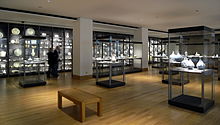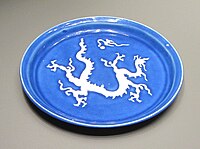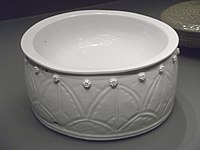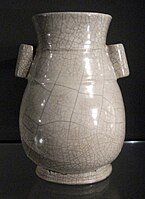Illustrated Catalogue of Qing Enamelled Ware in the Percival David Foundation of Chinese Art
Coordinates: 51°31′29″N 0°7′49″West / 51.52472°N 0.13028°W / 51.52472; -0.13028

The David Vases, said to exist two of the best-known Chinese porcelains in the earth
The Percival David Foundation of Chinese Fine art (abbreviated every bit the PDF) holds a collection of Chinese ceramics and related items assembled by Percival David that are on permanent display in a dedicated gallery in Room 95 at the British Museum. The Foundation'due south main purpose is to promote the study and educational activity of Chinese art and culture. The collection consists of some one,700 pieces, mostly of Song, Yuan, Ming and Qing dynasty porcelain from the tenth century to the 18th. It includes a painting, Gyre of Antiquities ( 古玩圖 Guwan tu , 1728, Yongzheng's reign).[1]
The collection concentrates on pieces in the "Chinese taste" rather than export wares, and on Regal porcelain, much of it Jingdezhen ware. Information technology includes examples of the rare Ru and Guan wares and 2 of import Yuan dynasty blue and white porcelain temple vases (the "David Vases"), the oldest dated bluish and white porcelain pieces, from 1351.[two] The Foundation also has a large library of Western and East Asian books related to Chinese fine art; this and archival textile are housed in the library of Schoolhouse of Oriental and African Studies (SOAS), University of London.
In 1950, the Drove was presented to the University of London by Sir Percival David. His drove was displayed in a house in Gordon Square and used as a focus for the didactics of Chinese art and civilization at SOAS. The collection has been on display in a special room at the British Museum since 2009.
History [edit]

Ii flasks with dragons, 1403–24
Percival David started collecting Chinese art some time around 1913, and he continued to practise and so until his expiry in 1964.[three] He first visited Mainland china in 1923, and there he gained an appreciation of Chinese ceramics. In 1925 he helped finance and mountain an exhibition of many of the all-time items of the imperial drove in the Forbidden Urban center in Beijing.[4] In 1927, he acquired some items that were originally from the Forbidden City when they came onto the marketplace. Many of these items were sold off by members of the Imperial Household Department during the tardily Qing dynasty, and Empress Dowager Cixi allegedly used these items as collateral for loans from the Yuin Yeh Bank in 1901.[iii] David managed to purchase some forty pieces one way or the other and export them to the United Kingdom. In 1930, he again returned to China and helped with various exhibitions and produced a series of catalogues of the pieces. However, much of the acquisition history of David's collection was unrecorded, but he may have acquired many of the items through various dealers, auctions and other collectors. The Yuan dynasty 'David Vases' in the collection were acquired from two separate sources.[iii] [five] Many pieces were likely once owned by the Qing dynasty emperors, and several pieces accept inscriptions added by the orders of the Qianlong Emperor (1736–95). The pieces assembled past Percival David class the well-nigh of import single collection of Chinese ceramics outside of China and Taiwan.
In 1931, David's collection was displayed in the Dorchester Hotel in London. Information technology remained there until it was evacuated to the countryside during World War II. David besides created a Chair in Chinese Art and Compages at the Courtauld Institute of Art, which is part of the University of London. Towards the end of his life, he was determined to proceed the collection together, and to this stop entered negotiations with the University of London. An understanding was reached to continue the collection and the library together in a foundation fastened to SOAS.
The chair that David had created was also moved to SOAS. Previous holders of the chair, called the Percival David Professor of Chinese and East Asian Art, include William Watson, Roderick Whitfield and Craig Clunas. The current incumbent is Shane McCausland. The collection was opened to the public on 10 June 1952 in a firm in Gordon Foursquare, Bloomsbury.

The quondam home of the Percival David Foundation in Gordon Square
The Foundation has lent many of its pieces to other countries. It lent many items of Yuan dynasty porcelain to Venice's 700th-anniversary commemoration of Marco Polo's expedition. Information technology has also sent other items to places every bit far away as Nippon and the United States.
The Library collection was a working library, open to researchers from around the world.
Relocation [edit]

Due to a funding crisis, the Gordon Square building housing the Foundation'south collection airtight at the end of 2007. The ceramics collection has been loaned on a long-term basis to the British Museum, where the whole collection, about i,700 objects, is on permanent public display in a specially designed new gallery (Room 95, British Museum) opened on 23 April 2009, sponsored by Sir Joseph Hotung.[2] The public gallery is role of the Sir Joseph Hotung Centre for Ceramic Studies, which includes facilities to apply the collection for teaching.
Chinese Ceramics: Highlights of the Sir Percival David Collection, by Regina Krahl and Jessica Harrison-Hall, was published in April 2009 by the British Museum Press to coincide with the opening of the new display.
Collection [edit]
David focused his collection of Chinese ceramics on stonewares and porcelain from the 10th to the 18th centuries (Song to Qing dynasties), with a few earlier pieces from the Half dozen Dynasties to the Tang. The earliest slice in the collection dates from the tertiary-century Western Jin. At that place are no pieces from the earlier periods of Chinese history because David chose not to collect any Chinese earthenware; the evolution of earthenware is found all around the world, and David'due south collection aims to give a representative overview of the development of ceramics that is unique to Mainland china. He chose the pieces based on the quality of the workmanship and historical importance with a view towards education.[6] Many pieces were regal wares of the Ming and Qing dynasty, and he collected an unusual number of the rare Song dynasty Ru ware.[7] Just before the opening of the drove in 1952, the foundation was also given a small collection of more often than not monochrome porcelain belonging to Mountstuart Elphinstone.[6]
At the British museum, the collection of the ane,700 items starts with the David Vases placed before the main infinite of Room 95. Effectually two hundred of the best pieces are displayed in cases in the centre of the room, with the remaining 1,500 pieces arranged more compactly in rows of glass shelves around the room.[two]
-

Case with over five% of the globe's surviving Ru ware, Song, c. 1100
-

-

-

Ming basin with peony blueprint, PDF 704
-

Wucai dish with dragons chasing flaming pearls, Ming, Longqing marker and period, 1567–1572, PDF 798
-

White dragon on a blue footing, produced with a rarely-used technique, Jingdezhen, Yuan dynasty
-

Vase with peach flower glaze, Jingdezhen, Kangxi period. PDF 579[viii]
-

-

An unusual blackness-glazed Ding ware, Northern Song
-

Monochrome porcelains, Qing dynasty
-

-

-

Ge ware, vase based on an ancient bronze form, Yuan dynasty
References [edit]
- ^ McCausland, Shane (2002). "The Emperor's Old Toys: Rethinking the Yongzheng (1723–35) Scroll of Antiquities in the Percival David Foundation". Transactions of the Oriental Ceramic Guild. 66: 65-75.
- ^ a b c "Sir Percival David Drove of Chinese Art". The British Museum. Archived from the original on 22 March 2010.
- ^ a b c Wang, Audrey (July 2012). Chinese Antiquities: An Introduction to the Art Market place. Lund Humphries Publishing. ISBN9781409455455.
- ^ "Chinese Ceramics, Percival David Collection". HiSoUR.com.
- ^ "altar-vase". British Museum.
- ^ a b Krahl, Regina; Harrison-Hall, Jessica (2009). Chinese Ceramics: Highlights of the Sir Percival David Collection. The British Museum Press. p. viii–9. ISBN978-0714124544.
- ^ Price, Katie (11 November 2015). "The Percival David Foundation of Chinese Art". Schoolhouse of Oriental and African Studies.
- ^ "Vase". The British Museum.
External links [edit]
| External video | |
|---|---|
| |
- British Museum, Room 95 including a Google virtual bout
- BBC audio file A History of the Earth in 100 Objects
- Illustrated catalogue of Ch'ing enamelled wares in the Percival David Foundation of Chinese Art from SOAS University of London
- A Handbook of Chinese Ceramics from the Metropolitan Museum of Art
Source: https://en.wikipedia.org/wiki/Percival_David_Foundation_of_Chinese_Art
0 Response to "Illustrated Catalogue of Qing Enamelled Ware in the Percival David Foundation of Chinese Art"
Post a Comment